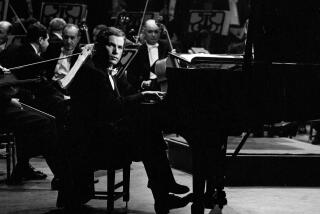Gould is gone, but melodies linger on
- Share via
NEW YORK — Pianist Glenn Gould played Bach’s “Goldberg” Variations in a 67th-floor condominium apartment here the other day.
Gould wasn’t there in person, of course: He retired from live performance more than 40 years ago and died in 1982. And indeed, the notes we heard him play were actually recorded in 1955, for the first of the more than 50 albums he made for Columbia Masterworks. And yet, unmistakably, there he was -- a disembodied presence at the Yamaha Disklavier Pro piano, playing high above Manhattan on a brilliant winter day.
This “re-performance,” as John Walker, founder and president of the Raleigh, N.C.-based Zenph Studios, calls it, was made possible by capturing as much information as possible from the 1955 recording, transforming it into computer files, and then playing it back on the $160,000 Disklavier Pro.
This instrument has everything that a typical Yamaha grand piano boasts -- the felt on the hammers, the pedals, the strings mounted to the metal sounding board, the 9-foot shining wooden encasement -- and one critical addition: a small computer no larger than a DVD player attached under the keyboard.
The basic concept is an old one, dating to the player pianos that were once so common in restaurants, saloons and grandparents’ basements. These were mechanically operated contraptions, set into motion by the vigorous pumping of foot pedals and pneumatic suction to “read” scrolls of perforated parchment that would then cause the instrument’s keys to depress and its hammers to strike the strings, usually loudly. But the music that came out of player pianos was just as mechanical as the instrument’s workings.
Zenph re-performances are infinitely richer and more complex, offering the listener a live experience rather than a recorded one.
“What we do is capture all the information available to us on a recording -- what notes were played, how they were pressed down, how long they were held down, how the hammers were released, even how the pianist picked his fingers up -- and re-create it exactly,” Walker said. “We have the technology to do this now.”
According to Walker, the Zenph process absorbs “every note and every nuance, carefully matching the timbre and dynamic range of the original piano playing” and compensating for the lesser quality of the original recording. “A modern recording, with microphones placed in different positions, reproduces the performance with much more detail and wide dynamic range that lets the polyphonic lines stand out more.”
The Gould estate has backed Zenph enthusiastically, to the extent of celebrating what would have been the pianist’s 74th birthday last September with the world premiere performance (and subsequent recording) of the new rendition at the Glenn Gould Studios in Toronto. For the benefit of those who haven’t yet purchased a Disklavier Pro -- there are only 300 of them in the world -- a “new” CD recording of the 1955 “Gouldbergs” will be released next month by Sony BMG.
According to Kevin Bazzana, a Gould biographer and the author of the program notes for the “re-performance” CD, “In effect, a long-dead pianist can now give live performances or make recordings of interpretations that are still recognizably his.”
After only one exposure, one can’t swear that this is a perfect “re-performance” -- although Gould’s fingerprints, metaphorically speaking, were clearly all over it. But it shows that such ventures are increasingly possible -- on the piano, at least (for various technical reasons, it is impossible to imagine this working for violin, cello or the human voice).
Walker was asked about further plans.
“We could certainly re-perform recordings by composer-pianists such as Ferruccio Busoni and Serge Rachmaninoff,” he said. “In fact, we have three cylinders by the Spanish composer Isaac Albiniz of improvisations that he never even wrote down. So we’ll both re-perform him on disc and allow the music to be transcribed for publication.”
The earliest sound recordings wouldn’t work -- there simply isn’t enough “information” within the recordings -- “but anything after 1910 is a piece of cake,” he said.
More to Read
The biggest entertainment stories
Get our big stories about Hollywood, film, television, music, arts, culture and more right in your inbox as soon as they publish.
You may occasionally receive promotional content from the Los Angeles Times.










